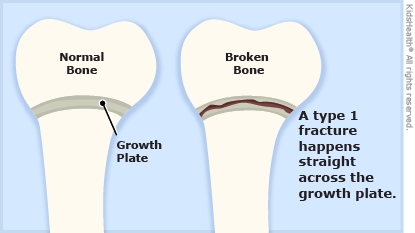The growth plate is a layer of cartilage near the end of a bone where most of the bone's growth happens. There are several types of growth plate fractures. Your child has a type 1 growth plate fracture, which is the mildest type. With proper care, this type of fracture heals within a month or so and does not affect the bone's growth.
A splint (support held in place with straps or an elastic bandage) was placed on your child's injured area to hold the bones in place. Take care of the splint and treat pain as instructed to keep your child comfortable while healing.


Follow your health care provider's recommendations for:
To help with pain and swelling:
Splint care:
Keep the splint dry:



How does a growth plate fracture happen? Growth plates are weaker than the rest of the bone and more prone to injury. Most commonly, a fracture happens when a growing child falls on or twists an arm or leg (for example, while running, skiing, or skateboarding). Growth plate fractures also can happen from doing the same activity over and over (for example, pitching a baseball or training for gymnastics).
How is a growth plate fracture diagnosed? Health care providers will order X-rays if they think a bone is broken. A mild growth plate fracture might not show up on an X-ray, though. So even when an X-ray is normal, if a growing child has pain near a growth plate, health care providers often will use a splint or brace, like a boot, to protect the area as it heals.
Will my child need a cast? Maybe. Your child will wear the splint until a follow-up visit with an orthopedist (bone specialist). The specialist will decide whether your child can wear the splint until the bone heals or gets a cast.